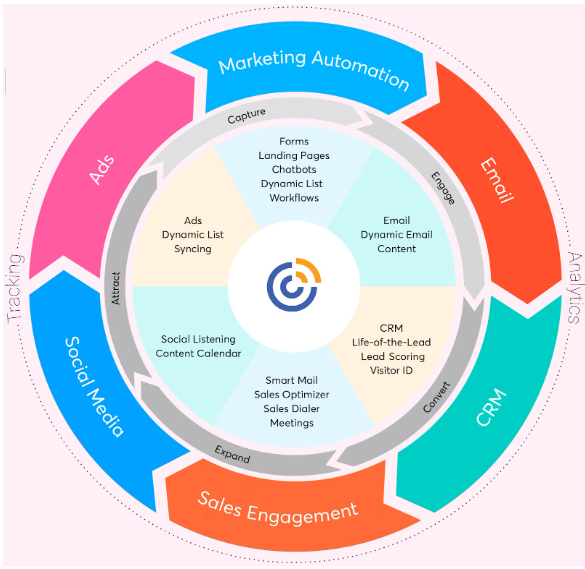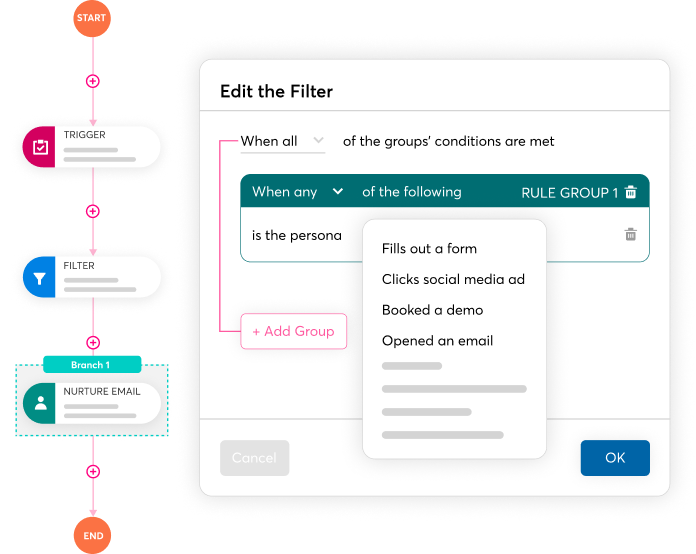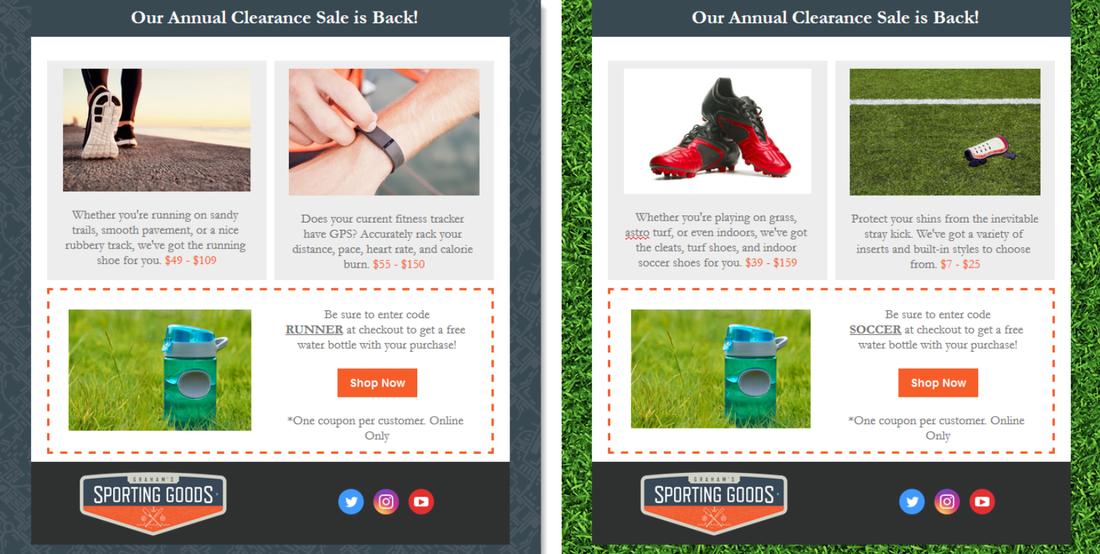|
When you run a business, time is your most valuable resource. But when time is money, it can seem like you never have enough — especially when so much of it is eaten up by crucial but tedious tasks that keep you away from the work you love. Marketing automation and customer relationship management (CRM) are two solutions for reclaiming some of that time. On their own, they’re each effective tools for boosting profitability, optimizing your business, and more. However, even in my own business operations, I’ve learned that by integrating CRM with automated marketing platforms, you can improve your customer interactions, reach more leads with relevant messaging, and improve the customer experience in less time. What is marketing automation? Marketing automation is a marketing approach that assigns repetitive marketing tasks to computer software. Taking cues from your business’s predetermined workflows, automated programs perform vital duties across today’s most common marketing channels, like email marketing, social media profiles, landing pages, and more. That said, marketing automation isn’t magic — no matter how much it sounds like it could be. Instead, automated marketing software takes advantage of a range of practical marketing tools and applies them to the techniques and practices your team is already implementing. These tools, however, have the finesse and precision only a computer could accomplish. For example, suppose a customer visits your website and fills out an opt-in form for your email list, indicating a desire to receive updates about special promotions and new products. Once upon a time, this relatively tiny act would have initiated a series of tasks for your team, including:
But email marketing automation can handle all of it. First, decide how you’d like your customer groups segmented and what marketing content each group should receive. Once you’ve set the parameters accordingly, when someone signs up, they’ll receive an automated welcome series that welcomes them and asks them a few questions about themselves — the answers are triggers for click segmentation. Automated click segmentation — the process of breaking down large customer groups into smaller ones based on things like demographics and location — ensures that the customer is on the right list, receiving the relevant information in their inbox. With a bit of input in the beginning, your automation platform can handle the rest. And that’s just one example. The benefits of automated marketing The primary benefit of automated marking is that it liberates marketing teams from complex repetitive tasks. It then completes them faster, more efficiently, and with a smaller margin of error. As a result, you unlock solutions for some of the most urgent challenges facing businesses, such as driving conversions, streamlining operations, and increasing your marketing ROI. But the benefits don’t stop there. By analyzing customer behavior and translating it into data, marketing automation enables you to pursue and nurture better, more qualified leads. Then, you can use that same data to deliver marketing content that’s relevant to customer needs and the solutions they’re looking for. That kind of customer-centric approach leads to better personalization, a must-have in today’s marketing environment. According to a survey from management consulting leader McKinsey & Company, 71% of customers expect personalized messaging, and 76% feel frustrated when they don’t get it. Marketing automation platforms make it easier for businesses of all sizes to meet and exceed those expectations by delivering:
Marketing automation can also help streamline business operations in your marketing department and beyond. For example, centralized data storage helps unify distinct teams who interact with customers at various points of their lifecycle journey. In short, marketing automation helps companies overcome common business challenges like generating and converting leads, enhancing and maintaining consumer engagement, and interpreting data. It then also helps you transform this input into opportunities for success. Marketing automation examples You see examples of marketing automation almost every day as a consumer. Think of when you receive an email thanking you for your purchase or notifying you that a product you like is on sale. Both messages are automated marketing in action. Even your favorite brands’ social media posts often come from automated scheduling software. Other examples of current marketing automation trends include:
Segmentation and sales funnels are two examples of ways automation can help you personalize content. Today’s marketing automation features make it easy to collect and sort information about your leads and customers. That information lets you send relevant messages, close sales, and boost your bottom line. What is CRM (customer relationship management)? Customer relationship management, or CRM, refers to software that helps businesses foster and sustain mutually beneficial relationships with customers. A CRM platform provides tools that streamline the processes of customer communication at every stage of the customer journey. Most modern businesses rely on multiple methods for reaching out to potential customers and keeping in touch with returning ones. One key function of CRM software is to collect and organize those communications across the many channels where they happen, including:
Another function of CRM software is to maintain important consumer data such as quotes, purchase history, interests, and demographic information. Then, this software organizes communication history and customer data in a centralized location, making it available to teams across your business. The benefits of CRM software Customer experience (CX) needs plenty of help, especially as more customer interactions shift to digital. Forrester’s research shows the quality of customer experiences decreased for 19% of brands in 2022. To change the picture, more customer care professionals and companies have shifted their focus to CX improvement. CRM makes it easier for any business to improve CX. It collects, formats, and organizes the data you need to offer a seamless experience, freeing you from organizing that information yourself. For instance, suppose you’ve programmed your CRM platform to record when a customer uses your website to take advantage of a special offer on a product, such as a discount, sale, or other promotion. Because that platform includes that information in the rest of that customer’s data, you can use it to schedule a follow-up contact, respond to future service requests, and influence future sales. You can also use CRM data to track your marketing campaign’s performance and make improvements for the future. Some of the most useful CRM metrics include:
For example, suppose your CRM collects information about each customer’s interactions leading up to a purchase. You might use that data to learn how many customers found you through one of your recent email campaigns. Divide the cost of that campaign by the number of customers it secured, and you have your CAC. CRM examples There are four types of CRM applications:
To find the best CRM for your business, consider what features you need and which features you’d like to see in the same package. Key differences between CRM and marketing automation The CRM–marketing automation distinction can get blurry, especially if you’re new to these tools. Here’s a brief side-by-side comparison of the two, plus some pointers to help you decide what you need. Who uses them As you might have guessed from the name, marketing automation is especially useful as a tool for your marketing team. Plus, its solutions touch every phase of the sales funnel. It powers the earliest touchpoints where business-customer relations are established, refines the customer experience as they move toward a purchase, and encourages them to return after purchase. Like automation, CRM software also helps marketing teams but is primarily designed to be used by sales and CX departments. These professionals deal with consumers who have already entered the funnel — in other words, those who’ve had their first interaction with your company. Sales teams use CRM software to manage leads, giving them the right kind of attention so they move toward a sale. CX and customer success teams pick up the trail after the first purchase. They ensure the customer has a great experience with the product and in service interactions. CRMs are also helpful for business development and planning purposes. They tell you what your customers want, how they interact with you, and what marketing and sales strategies engage them best. What they do A marketing automation platform lets you program specific actions based on “triggers.” A trigger is a marketing-relevant event or condition, such as an abandoned cart, a prospect signing up for your mailing list, or a reader clicking on a link in your email campaign. When a trigger happens, the platform launches a specific task. This is how it works: This simple workflow can accomplish dozens of tasks, from sending email newsletters at specified times to presenting shoppers with the right content based on their purchase readiness. CRMs organize the data that powers these and many other workflows. Depending on the platform, they do some to all of the following:
The best CRMs communicate with your existing marketing, sales, and service software. The more customer data you have for those processes, the better your customers’ experience will be. What they accomplish CRM marketing automation platforms save you time and help you build stronger customer relationships. Marketing automation accomplishes these goals by running manual tasks behind the scenes. While you focus on building customer relationships, your marketing automation platform effortlessly collects and acts on those customers’ data. CRM tools handle the organizational side of the picture. If automated marketing is your assembly-line robot, doing your “if this, then that” tasks, CRM software organizes the materials behind the scenes. It sorts crucial information, from lead demographics to details on a customer’s most recent service interaction, so your team can get the data they need. Many CRM tools integrate with marketing automation platforms, simplifying the process of collecting and analyzing valuable customer information. How can CRM and marketing automation work together in your favor? At this point, you’ve learned what marketing automation software and CRM platforms can do alone. The CRM marketing automation connection expands the possibilities of each tool to upgrade your customer experience. Improving customer interactions CRM and marketing automation platforms make every customer interaction more meaningful when used together. CRMs gather all of a customer’s or lead’s pertinent data so that you can send personalized recommendations and messages. Marketing automation helps you reach every customer and potential customer with these personalized touchpoints. By integrating CRM data into your automated messages, you can send customer-specific content and increase your chances of making a sale. Here’s how this looks in real life: Marketing automation and CRM integration also improve the service experience. According to a TotalRetail survey, 65% of customers have to contact a company more than once to resolve an issue, and 25% need three or more touchpoints. CRM and marketing automation make it easier to fix problems on the first try. CRM software gives your team on-demand access to each customer’s interaction history, including service chats and support tickets. This way, the customer doesn’t have to repeat themselves, and your support team can make a great impression by referring to previous customer experiences — building better, stronger relationships with your customers. Shortening your sales processes CRM and marketing automation systems shorten your sales process by eliminating repetitive processes and keeping teams connected. With a CRM, sales and marketing professionals have easy access to the same information. No more endless email chains or missed information that costs you sales. CRMs also make it easier to track each lead and take action based on where they are in the sales funnel. Adding automation instantly launches many of those actions, so customers move toward a purchase with little to no hands-on effort from your team — shortening the time to a sale. Providing deeper insight into your business’s performance There’s considerable overlap between CRMs and marketing automation regarding consumer data. CRMs collect data from sales and communication before organizing it and making it accessible to teams across departments. That data can provide important insights into your sales process. You can see at a glance which deals are progressing quickly and which have stalled. If you dig deeper, you can find common threads among won and lost sales. Furthermore, data is crucial for marketing automation, as it informs and improves essentially every automation that occurs, from SMS marketing and abandoned cart emails to social media campaigns and more. Plus, your marketing team can use data collected by your CRM to evaluate the success of your current marketing efforts, devise solutions for those that aren’t working, and develop new strategies to enhance profitability. Reducing the pitfalls that come with manual processes Manual work has two things going against it: It’s slow and leaves you vulnerable to human error. A simple typo on a customer entry form can lose you a sale as your next email goes to the wrong person. Additionally, manual entry may mean that you miss a vital step. An integrated CRM marketing automation platform catches all the little details, such as what type of message a person has engaged with or what product categories they’ve bought from. That information is essential for sending the personalized messages customers expect. How to integrate CRM and marketing automation software Before you get started with marketing automation and CRM, you’ll need to choose platforms that connect easily. Some solutions have integrated CRM and marketing automation features and tutorials to help you set up those connections. If you’re starting from scratch, choosing a one-stop solution as such will be your best bet. If you already have a CRM or marketing automation software, dig into its integration capabilities. Many tools have specific brand integrations that will narrow down your choices. Or, you might find that your CRM already has automation capabilities you can tap into. The more automations you can set up through your CRM, the better. Remember, each automated process is one more thing you and your team don’t have to handle personally. Optimize your marketing efforts with CRM and marketing automation tools Now you understand the power of CRM platforms for improving the customer experience and CRM marketing automation to save you time on data collection, analysis, and integration. It provides a unique opportunity to personalize marketing at scale and offer relevant messaging to every customer. Most importantly, you can put all of this to use right away. If you already have an integrated platform, start exploring its features and what you can do with it. Consider your current marketing strategies and any campaigns you have in the pipeline. Examine how you currently use customer data to personalize your outreach. Then, think about what you’d like to personalize if you had an organized system. For example, maybe you’d create segmented email drip campaigns but don’t have the data to truly personalize them yet. Once you identify the need, choose a CRM platform that you can get started with right away. Begin by integrating any existing customer data, then connect the platform to your email signup system and any other ways you collect data. This information will let you create your first automated campaign, streamlining and transforming your marketing strategy from here on out. Source: https://www.constantcontact.com
0 Comments
|
Membership is open to businesses and organizations interested in increasing visibility and brand awareness in Westchester County and surrounding areas.
Archives
May 2024
Categories
All
|





 RSS Feed
RSS Feed